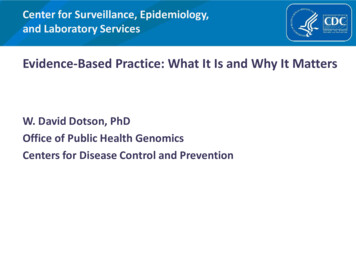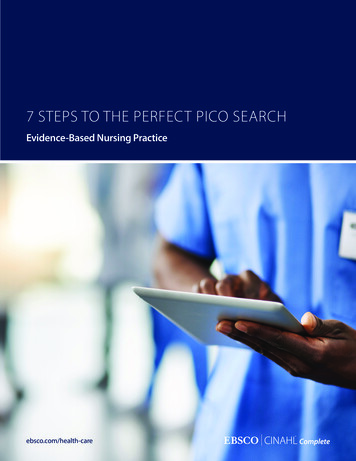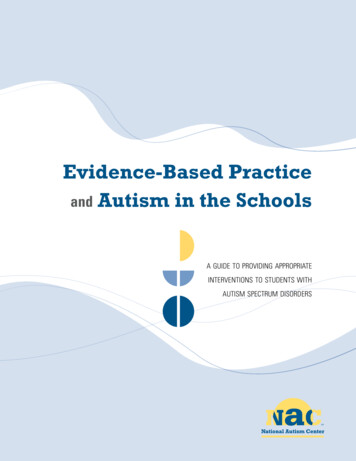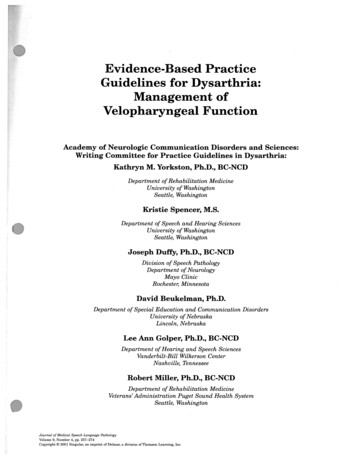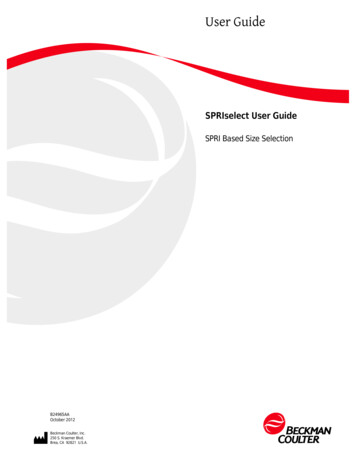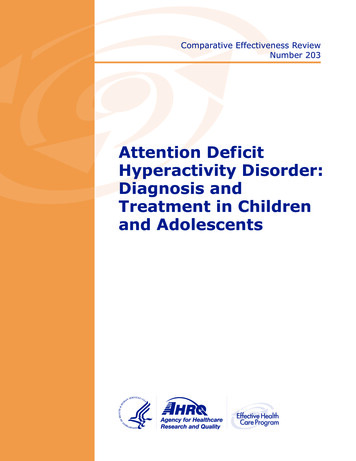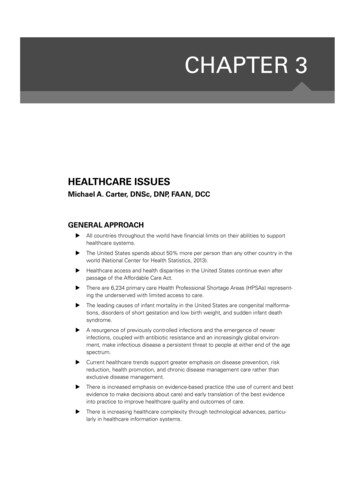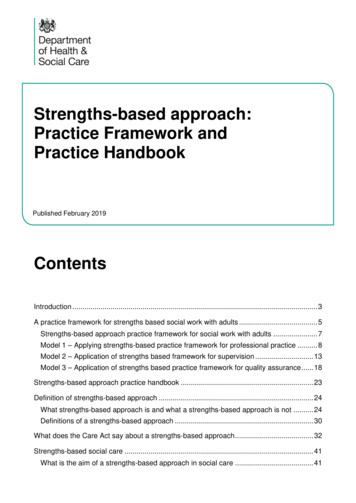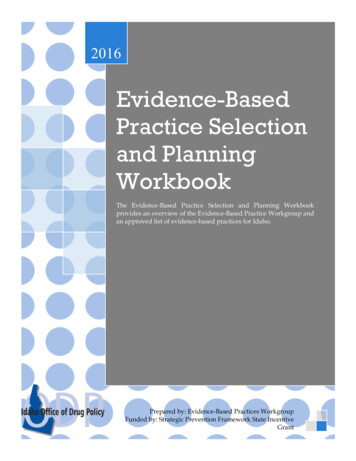
Transcription
2016Evidence-BasedPractice Selectionand PlanningWorkbookThe Evidence-Based Practice Selection and Planning Workbookprovides an overview of the Evidence-Based Practice Workgroup andan approved list of evidence-based practices for Idaho.Prepared by: Evidence-Based Practices WorkgroupFunded by: Strategic Prevention Framework State IncentiveGrant
AcknowledgementsThis workbook is the result of a collaborative effort by the members of the Idaho StrategicPrevention Framework (SPF) Evidence-Based Practices (EBP) Workgroup. The workgroup ismade up of the following members and organizations:Evidence Based Practice Workgroup (EBP)NameAgencySharlene JohnsonOffice of Drug PolicyStephanie LindsayOffice of Drug PolicyNicole FitzgeraldOffice of Drug PolicyMonty ProwDepartment of Juvenile CorrectionJaneena WingDepartment of CorrectionMatt McCarterDepartment of EducationRob OwensIdaho Supreme CourtTaunya JonesIdaho Supreme CourtJanet ReisCenter for Health PolicyJamie Lou DelavanDepartment of Health and Welfare1
Table of ContentsIntroduction3What is an Evidence-Based Practice?What is the Purpose of this Document?How Does this Document Fit within the SPF Model?Who should be Involved in the Strategy Selection Process?Prevention Models4Public Health ModelSocial-Ecological ModelTypes of Prevention Strategies6Individual StrategiesEnvironmental StrategiesRoot Causes and Local Conditions7Actionable Root CausesRelationship between Root Causes and Local ConditionsLogic ModelsStrategic PlanSelecting Good Fit Prevention EBPs8910Why is Assessing Fit Important?Six Components of Good FitStrategy Test Fit Form13Appendix A: Glossary of TermsAppendix B: Evidence-Based StrategiesAppendix C: Evidence-Based ProgramsAppendix D: Resources14162327References372
IntroductionWhat is an Evidence-Based Practice?In substance abuse prevention, evidence-based practices (EBP) generally refer to approaches that arevalidated by documented evidence. EBPs stand in contrast to approaches that are based on tradition,convention, belief, or anecdotal evidence.What is the Purpose of this Document?The purpose of the Evidence-Based Practice Selection and Planning Workbook is to provide StrategicPrevention Framework (SPF) and Substance Abuse Prevention Block Grant (SABG) grantees with aset of guidelines for choosing the most appropriate and best fitting prevention strategies andprograms for their community, see Appendices B and C, respectively. This document includes a listof approved EBPs compiled by the EBP Workgroup (EBPW). Grantees are invited to select EBPs fromthis listing. In the event that an EBP is not included on the approved list, the grantee may submit anapplication to the EBPW for approval. That process will be discussed further in Appendix D.How Does this Document Fit within the SPF Model?The first two stages of the SPF model are assessment and capacity. During these stages, granteesgather information to determine the community’s problems, rootcauses and local conditions, select priorities, and complete logicmodels for each problem. To ensure a greater likelihood of success fora community, this document is designed to help grantees selectstrategies that complement the community’s specific needs asaddressed in the assessment and capacity phases. Needs, priorities,community readiness, coalition capacity, and existing preventionefforts should all be evaluated before selecting a strategy.Who should be Involved in the Strategy Selection Process?Similar to the assessment and capacity phases, the entire coalition should have input when selectingevidence-based prevention strategies. People support what they help create. By involving allcoalition members in the selection process, it will provide each member the chance to help developthe coalition’s strategic plan for prevention.3
Prevention ModelsPublic Health ModelThe Public Health Model demonstrates the relationship that substance abuse can have on theindividual. Three components play a role insubstance use and abuse: the host, the agent, and theenvironment. The host is the person affected bysubstance use, the environment is the situation inwhich substance use occurs, and the agent is thesubstance used. It takes all three components of thePublic Health Model to develop a substance abuseproblem within the community. To combat substanceuse and abuse, prevention efforts must be targeted atone or more areas of the Public Health Model.The Public Health Model embraces a comprehensiveapproach to community change. Manipulating the(New Mexico Assessment Training Manual, 2006)environment that allows substance use in the community greatly impacts prevention efforts. Prior tothe SPF, grantees may have been encouraged to work within four identified prevention domains:individual, family, school, and community. Now, SPF funded coalitions may continue to workwithin these domains, but will be required to focus on strategies that will bring about environmentalchange.Social-Ecological ModelBefore choosing a strategy, it is appropriate todetermine what will likely stimulate thegreatest changes to a community’s root causes,local conditions, and prevention priorities. Acomprehensive prevention plan shouldidentify a mix of strategies that target localconditions in multiple contexts and levels. TheSocial-Ecological Model (Bronfenbrenner,1979) is a multi-faceted public health modelgrounded in the belief that to achievesustainable changes in individual behavior,prevention efforts must target the social andecological environment that individualsinteract with.4
The social-ecological model consists of four levels that a prevention effort should strive to impact.The four levels consist of:IndividualThe individual level encompasses the knowledge, attitudes, and skills of the individuals within thetarget population. This level can be influenced by individual-level interventions (such as educationaland skill-building programs) as well as environmental interventions such as media and socialmarketing campaigns. An example of an individual level intervention would be a program for highrisk students to improve self-confidence and skills to resist alcohol and drugs.MicrosystemThe microsystem is comprised of the relationships that impact the individual. This level includes thefamily, friends, and peers of the individuals within the target population. The microsystem has theability to shape the behaviors of the individuals in the target population. The microsystem can beinfluenced by enhancing social supports and social networks, as well as changing group norms andrules. An example of an intervention in the microsystem would be an educational program to teachparents how to better establish clear rules regarding alcohol, tobacco, or other drugs.ExosystemThe exosystem is comprised of the communities that impact the individual. This level includes theunique environments in which the individuals in the target population spend their time. The media,workplaces, schools, churches, neighborhoods, sports teams, and volunteer groups are consideredcomponents of the exosystem. This level can be influenced by changes to rules, regulations, andpolicies within the different community organizations and structures. An example of a communitylevel intervention would be the adoption of an alcohol free policy by a local company for all workrelated functions and events.MacrosystemThe macrosystem is comprised of the societies that impact the individual. This level includes thelarger factions that influence the behaviors of the individuals in the target population. Laws, policies,history, social conditions, economic systems, and culture are considered components of themacrosystem. This level can be influenced by changing state and local laws, policies, and practices, aswell as other initiatives designed to change social norms within the target population. An example ofa societal level intervention would be implementing a social host ordinance.5
Types of Prevention StrategiesPrevention strategies typically fall into two categories: environmental and individual.Individual StrategiesIndividual strategies target the knowledge, attitudes, and skills of individuals. For the purpose of theSPF, individual strategies are also referred to as program-level strategies. Individual strategies focuson the individual in the Public Health Model and are found in the two inner layers of the SocialEcological model.Environmental StrategiesEnvironmental strategies target the broader physical, social, cultural, and institutional forces thatcontribute to problem behaviors. For the purpose of SPF, environmental strategies are also referred toas community-level strategies. Environmental strategies focus on the environment in Public HealthModel and are found in the two outer layers of the Social-Ecological model.Particular attention should be given to the implementation of evidence-based environmentalstrategies. According to the Community Anti-Drug Coalitions of America (CADCA), environmentalstrategies can produce widespread and lasting behavior change by making appropriate (or healthy)behaviors more achievable for the individuals in the target population. Environmental strategies canachieve behavior change through modifications to policies, practices, systems, and norms.Furthermore, these strategies can result in behavior changes that reduce problems for the entirecommunity, including those outside the target population.Because environmental strategies require substantial commitment from various sectors of thecommunity, long-term relationships should be established with key community stakeholders.The costs associated with environmental strategies can be considerably lower than those associatedwith ongoing education, services, and therapeutic efforts applied to individuals.In summary, it is recommendation that your coalition use a multi-strategy approach in targeting rootcauses, local conditions, and priorities. As part of this multi-strategy approach, it is particularlyimportant for coalitions to choose one or more environmental strategies to impact the communityand society thereby influencing the individuals in the target population. Failure to implementstrategies at multiple levels of the Social-Ecological Model greatly decreases the likelihood that agrantee will achieving long-term success in a community.6
Root Causes and Local ConditionsRoot causes for environmental strategies: Retail Access/Availability Social Access/Availability Promotion Social Norms/Community Norms Perceived Risk /Individual Factors EnforcementActionable Root CausesPrior to choosing your prevention strategies, reflect on the root causes in your community. Rootcauses drive the problem that an evidence-based prevention strategy will directly try to affect. Localconditions should be specific, actionable, and answer the question “Why is this local conditionproblem in my community?” In some instances, root causes may need further thought anddiscussion. Here is an example of when this might occur:Based on the results of a survey, you have identified social availability as one of your root causes. While socialavailability is important to your community prevention efforts and grounded in solid evidence, it is notactionable without further information. To refine the root cause, one must ask why the problem is occurring inthe community. From various focus group interviews, it becomes evident that, parents think that it is OK toprovide alcohol to minors for special occasions. Possible local conditions for this example could be: parents don’tknow that it is illegal or do not understand the law; the law is not enforced (which provokes other questions andrelates to other root causes); or parents believe it is safer for kids to drink at home. Interviews, focus groups,town hall meetings, and other data collection efforts during the assessment phase should help answer thisquestion.Relationship between Root Causes and Local ConditionsAssessment data determines the problems, root causes and local conditions, and should be affectedby the prevention strategies. More assessment may be necessary if no data exists.Local conditions are specific issues in a community that allow root causes to exist. Root causes andlocal conditions are used to identifying appropriate strategies. Each root cause must have two ormore local conditions.7
Logic ModelsTo help grantees visualize how root causes, local conditions, and priorities are related, grantees willfirst create a logic model. Each community will submit a logic model.Four components should be included in the logic model: Ultimate outcome/aim Root causes Local conditions Data measures for eachLogic Model Example:Aim: Reduce 30-day alcohol use among high school students by 5% by 2016.8
Strategic PlanThe Strategic Plan is a narrative to describe and justify the approach the coalition is taking on eachpriority. The strategic plan is an extension of the logic models. Also, it includes dosage and targetpopulation information, and summarizes the community’s capacity and cultural competence relatedto the implementation of the selected strategies.Strategic planning is about what and action planning is about how. There are found components to astrategic plan: Vision States what the group would like to accomplish Mission Describes the organization’s role in making the vision a reality Objectives SMART C Specific Measureable Achievable Relevant Timed Community-Level Strategies Provides a way to achieve objectives9
Selecting Good Fit Prevention EBPsTo have a good fit within your community, it is preferable that prevention EBPs meet several criteria.An EBP must have evidence of past success, and it must also fit conceptually with your targetedintervening variables. EBPs must fitpractically within your community andcoalition and should be able to beimplemented in your community withfidelity (meaning implemented as intendedby the author). In addition, a good fittingEBP should be culturally appropriate andsustainable within your community.Why is Assessing Fit Important? To match that the selected strategiesto the needs and characteristics of the targetpopulation To ensure that the plan to impact priorities complements, and not conflicts with, the activitiesand programs of other agencies and organizations To prevent excessive duplication of efforts in the community To ensure the community can support the plan to impact the priorities To ensure that adequate resources exist to implement your plan properly To ensure sufficient capacity in implementing your plan, thereby increasing the likelihood forsuccess To refine how other local efforts (e.g., community coalitions, environmental strategies,prevention programs) can be utilized as resources to increase community buy-in for yourplans to impact the identified prioritySix Components of Good Fit1. Evidence of EffectivenessAll Selected EBPs Must: Have documented evidence of effectiveness and preferably have been rigorously tested andshown to have positive outcomes in peer-reviewed evaluation studies Be effective according to EITHER: Idaho’s pre-approved EBP listOR Approved by the Evidence-Based Practice Workgroup. The process for submitting anEBP to be reviewed is listed in Appendices D and E.10
2. Conceptual Fit with the Communities Prevention PrioritiesA Good Conceptual Fit EBP Should: Address the root causes and local conditions chosen by the coalitionDrive positive outcomes for prevention priorities, root causes, and local conditionsShow effectiveness within the target populationHave logical if-then statements If-then statements help connect EBPs to the substance abuse data that changes in thecommunity. This connection allows for better understanding for whether an EBP fitsconceptually into the overall SPF prevention plan. Ultimately, EBPs should positivelyimpact root causes, local conditions, and priorities. Here is an example of when thismight occur:Social availability is a local condition, and the root cause is that parents are providing alcohol to their children.After further exploration, it is evidence that the real issue is that parents do not understand the law. As a result,you want to implement an EBP to help educate parents about the laws related to providing alcohol to minors inyour community. If we educate parents about the laws, then they will be less likely to provide alcoholto their underage childrenIf parents are not providing alcohol to their children, then minors in the communitywill have reduced social access to alcoholIf minors have reduced social access to alcohol, then the rates of drinking willdecrease3. Practical Fit with the Communities Readiness and CapacityAn EBP is a Practical Fit for the Community If: The coalition has the necessary staff and funding The coalition has the necessary collaboration (police, leaders, etc.) The community will support this EBP (high level of readiness)4. Ability to Implement with FidelityAll Selected EBPs Should be Implemented as Intended and Where Possible Include: A target population that is similar (in demographic and number) to the previously researchedpopulation for that EBP All elements of the strategy, rather than picking and choosing some of the elements toimplement A similar timeline and method to the previous documented research for that EBP Similar data collection processes as previously documented in the research for that EBP11
5. Cultural Fit Within the CommunityAn EBP has a Cultural Fit If: The strategy has been shown to be effective for the demographic of the target populationThe strategy is applicable and appropriate for culturally diverse populations in the communityThe strategy conforms to cultural beliefs and practices of the target populationSupportive materials for the strategy are properly translated6. High Likelihood of Sustainability within the CommunityAn EBP has a High Likelihood of Sustainability If: Documented evaluation and research studies have demonstrated sustainable outcomes Community leaders and stakeholders believe the strategy is important and are committed tosustaining it The strategy can be sustained with little or no direct cost following implementationAt a minimum, selected strategies must be evidence-based, fit conceptually, and fit practically withinthe community. In addition, strategies should be implemented with fidelity, culturally appropriatefor the target population, and sustainable within the community.If the strategy does not meet all the components of a good fit, first identify what is missing andsecond, how to add those missing pieces. To help determine whether a strategy is a good fit for thecommunity, use the proposed Strategy Test Fit Form on page 13.12
Strategy Test Fit FormThis form will help your community determine if the proposed strategy meets the good fit criteria.This form does not need to be submitted to ODPWhat strategy approval category does this strategy fall under?On the list of Idaho approved EBPs (Appendices B and C)Not on the list of Idaho approved EBPs (see Appendices D and E for theEBPW Manual and EBP application)Who is the target population for this strategy?Which of your local condition(s) will this strategy try and impact?Which of your root cause(s) will this strategy try and impact?Complete a theoretical if-then proposition for this strategy. (Conceptual Fit)Demonstrate that your community has the readiness and capacity to effectively implement thisstrategy. (Practical Fit)Will this strategy be implemented as intended in your community? (Fidelity)Yes, this strategy will be implemented as intendedNo, we will be making some changes to how this strategy is implemented tobetter address our target population or the readiness/abilities of ourcommunity/coalitionIs this strategy culturally appropriate and culturally relevant for your target population? (CulturalFit)Yes, this strategy is culturally appropriate and relevant as intendedYes, but we have modified it to make it more culturally appropriate andrelevant for our communityWhat will be needed to sustain this strategy in your community beyond the SPF Project?(Sustainability)Additional fundingStrong support from stakeholdersAlmost nothing, it should be sustainable on its ownOther, please specify:13
Appendix A: Glossary of TermsTermCADCAStrategies forCommunityLevel ChangeExplanationProviding Information – Educational presentations, workshops or seminars or other presentationsof data (e.g., public announcements, brochures, dissemination, billboards, community meetings,forums, web-based communication).Enhancing Skills – Workshops, seminars or other activities designed to increase the skills ofparticipants, members and staff needed to achieve population level outcomes (e.g., training,technical assistance, distance learning, strategic planning retreats, curricula development).Providing Support – Creating opportunities to support people to participate in activities that reducerisk or enhance protection (e.g., providing alternative activities, mentoring, referrals, supportgroups or clubs).Enhancing Access/Reducing Barriers- Improving systems and processes to increase the ease, abilityand opportunity to utilize those systems and services (e.g., assuring healthcare, childcare,transportation, housing, justice, education, safety, special needs, cultural and language sensitivity).Changing Consequences (Incentives/Disincentives) – Increasing or decreasing the probability of aspecific behavior that reduces risk or enhances protection by altering the consequences forperforming that behavior (e.g., increasing public recognition for deserved behavior, individual andbusiness rewards, taxes, citations, fines, revocations/loss of privileges).Physical Design – Changing the physical design or structure of the environment to reduce risk orenhance protection (e.g., parks, landscapes, signage, lighting, outlet density).CSAPPreventionStrategy TypeModifying/Changing Policies – Formal change in written procedures, by-laws, proclamations, rulesor laws with written documentation and/or voting procedures (e.g., workplace initiatives, lawenforcement procedures and practices, public policy actions, systems change within government,communities and organizations).Information dissemination – This strategy provides awareness and knowledge of the nature andextent of alcohol, tobacco and drug use, abuse and addiction and their effects on individuals,families and communities. It also provides knowledge and awareness of available preventionprograms and services. Information dissemination is characterized by one-way communicationfrom the source to the audience, with limited contact between the two.Education – This strategy involves two-way communication and is distinguished from theInformation Dissemination strategy by the fact that interaction between the educator/facilitator andthe participants is the basis of its activities. Activities under this strategy aim to affect critical lifeand social skills, including decision-making, refusal skills, critical analysis (e.g., of media messages)and systematic judgment abilities.Alternatives - This strategy provides for the participation of target populations in activities thatexclude alcohol, tobacco and other drug use. The assumption is that constructive and healthyactivities offset the attraction to, or otherwise meet the needs usually filled by alcohol, tobacco andother drugs and would, therefore, minimize or obviate resort to the latter.Environmental - This strategy establishes or changes written and unwritten community standards,codes and attitudes, thereby influencing incidence and prevalence of the abuse of alcohol, tobaccoand other drugs used in the general population. This strategy is divided into two subcategories topermit distinction between activities which center on legal and regulatory initiatives and those thatrelate to the service and action oriented initiatives.Community-Based Process: This strategy aims to enhance the ability of the community to moreeffectively provide prevention and treatment services for alcohol, tobacco and drug abuse disorders.Activities in this strategy include organizing, planning, enhancing efficiency and effectiveness of14
Evidence-basedImplementationResourcesInstitute ofMedicineCategoriesservices implementation, interagency collaboration, coalition building and networking.Problem Identification and Referral - This strategy aims at identification of those who haveindulged in illegal/age-inappropriate use of tobacco or alcohol and those individuals who haveindulged in the first use of illicit drugs in order to assess if their behavior can be reversed througheducation. It should be noted, however, that this strategy does not include any activity designed todetermine if a person is in need of treatment.The basis for the selected strategy/program being declared evidence-basedBlueprints is a searchable online registry of substance abuse and mental health interventions.Blueprints was developed to help the public learn more about evidence-based interventions that areavailable for implementation.Where you can go to find out more about the strategy/program in questionUniversal Direct – directly serve a group of participants that has not been identified on the basis ofindividual risk (e.g. school curriculum, parenting class). This also could include interventionsinvolving interpersonal and ongoing contact (e.g., coalitions).Universal Indirect – Interventions support population-based programs and environmentalstrategies (e.g., establishing ATOD policies). This could also include programs and policiesimplemented by coalitions.Selective – Selective interventions target those at higher-than-average risk for substance abuse;individuals are identified by the magnitude and nature of risk factors for substance abuse to whichthey are exposed. Selective prevention measure target subsets of the total population that areconsidered at risk for substance abuse my virtue of their membership in a particular segment of thepopulation. Selective prevention targets the entire subgroup, regardless of the degree or risk of anyindividual within the group.EBP StatusRisk orProtectiveFactor DomainsAddressedIndicated – Indicated interventions target those already using or engaging in other high-riskbehaviors to prevention heavy or chronic use.Indicated prevention measures are designed to prevent the onset of substance abuse in individualswho do not meet the medical criteria for addiction, but who are showing early danger signs. Themission of indicated prevention is to identify individuals who are exhibiting problem behaviors andto involve them in special programs.Approved – EBPs that are considered approved are those that have shown to be effective in researchor are on a national registry such as the Blueprints.Provisional – EBPs that are considered provisions are those that have been submitted to the EBPWfor review. This process is outlined in Appendix D.Community - community transitions and mobility, community disorganization, low neighborhoodattachment, laws and norms favorable toward drug use, availability of drugs and opportunities andrewards for prosocial involvement.Family - family history of antisocial behavior and conflict, parental attitudes, poor familymanagement, and family attachmentSchool - academic failure, low school commitment, antisocial behavior at school, extracurricularactivity participationSPF SIGPrioritiesTargetPopulationIndividual – favorable attitudes towards antisocial behavior and drugs, age of initiation, perceptionof peers use of drugs and risk, gang involvement, sensation seeking, religiosity, social skills, andethics.One of the three possible SPF SIG priorities addressed; alcohol, marijuana, prescription drugsThe demographic in which the strategy/program seeks to address15
Appendix B: Evidence-Based StrategiesPrevention StrategiesTargetPopulationContributingFactorsCSAP Prevention StrategyTypeCADCA Strategy forCommunity Level ChangeRisk orProtective FactorDomainsAddressedInstitute ofMedicineCategoriesEBPStatusStrategies for All PrioritiesIncrease or change zoning restrictionsAll agesRetail access,Enforcement,Social normsEnvironmental StrategiesEnhance Access/Reduce Barriers,Change Physical Design,Modify/Change PoliciesCommunityUniversal Direct,Universal IndirectApprovedAdopt a noise assembly ordinanceAll agesSocial access,Social normsEnvironmental StrategiesEnhance Access/Reduce Barriers,Change Consequences,Modify/Change PoliciesCommunityUniversal indirectApprovedCommunity based Process,Environmental StrategiesEnhance Access/Reduce Barriers,Change Consequences,Modify/Change PoliciesCommunityUniversal indirectApprovedCommunity based Process,Environmental StrategiesChange Consequences,Modify/Change PoliciesCommunityUniversal indirectApprovedCommunity based Process,Problem Identification andReferralProvide Support,Modify/Change onmental StrategiesModify/Change PoliciesCommunityUniversal directApprovedEnvironmental StrategiesModify/Change PoliciesCommunityUniversal directApprovedEnvironmental StrategiesChange ConsequencesCommunityUniversal directApprovedInformation Dissemination,Community based Process,Environmental StrategiesProvide InformationCommunityUniversal directApprovedEnhance law enforcement capacity andcommitment to address substance abuselawsAll agesStrengthen the prosecution,adjudication, and sanctioning ofsubstance abuse laws within the courtsystemAll agesAdopt a policy for referral of patientswho are believed to be substance abusedependentAll agesEstablish or strengthen policies relatedto alcohol and drug use amongemployeesEmployeesEnhance enforcement of worksitepoliciesEmployeesReprimand supervisors who fail toenforce the policiesEmployeesImplement education/awarenesscampaigns within worksitesEmployeesEnforcement,Social norms,Low perceivedriskEnforcement,Social norms,Low perceivedr
Workbook The Evidence-Based Practice Selection and Planning Workbook . The Public Health Model demonstrates the relationship that substance abuse can have on the individual. Three components play a role in substance use and abuse: the host, the agent
